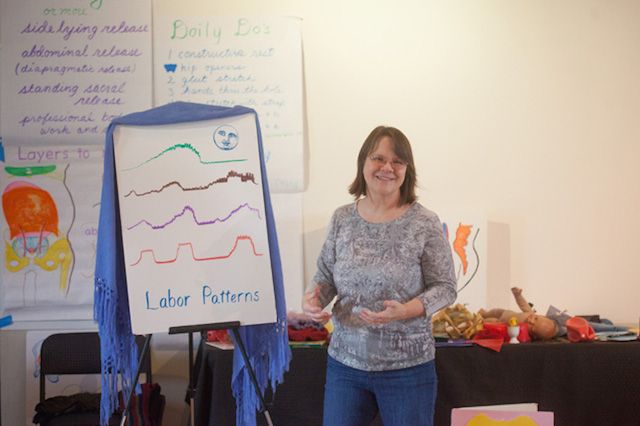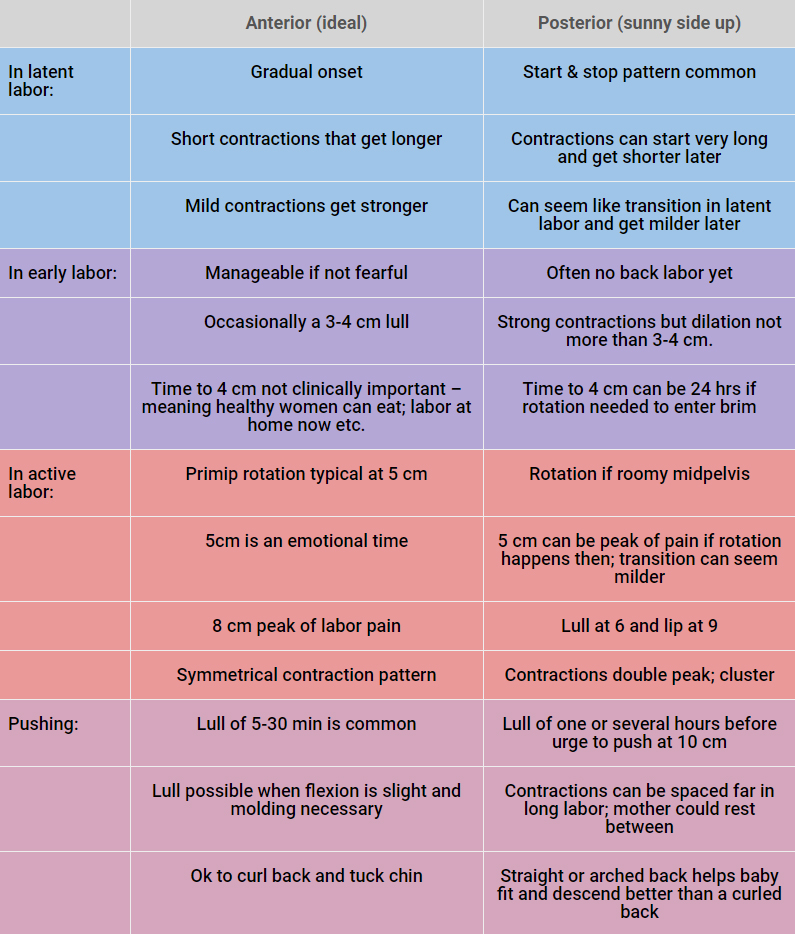
This is the labor pattern in which the contractions come at fairly regular and increasing intervals:
These are contraction variations that tell us the uterus is working to fit the baby through the pelvis. The contractions are pretty steady, but the cervix opens slowly. Contractions intervals can be unpredictable. Alarmingly strong contractions can occur at 2 cm but calm down for a while as the uterus rests. Mild contractions can occur when the uterus rests at 7 cm after a period of strong contractions. There is not a predictable increase of intensity and frequency of contractions rewarded by increasing dilation.
Contractions may come in double peaks (one big one with a lingering second peak). Sometimes a cluster of big contractions will come between a period of not-so-strong contractions. The intensity may not match the dilation of the cervix compared to the regular pattern. We begin to wonder if baby is facing forward in the pelvis.
Is the baby known to be posterior? When the baby is coming into the pelvis in the posterior position, we want to know if the baby will continue to fit in the posterior position or if we need to rotate. We don’t usually get to know this, so an educated guess is required. If labor is moving along readily, we can assume it will continue to do so. If labor is slow, we should hope the baby fits. We can choose to be patient or we can try to rotate the baby. Spinning Babies® is the active side of patience.
A couple days may pass with this unpredictable pattern as the baby seeks a way down on to the cervix and through the pelvis.
This pattern can be considered an “invitation to act”. Add body balancing as described in Spinning Babies® Three Principles of Balance, Gravity and Movement.
Occasionally, the uterus gets tired and stalls. The contractions are now less painful and the birthing person can sleep. When rest happens after the uterus has accomplished a goal, such as fetal rotation or engagement, the next time labor starts up, a regular labor pattern brings the baby. Fetal rotation is labor progress even when the cervix hasn’t changed much.
Add body balancing techniques from our techniques list to help align the uterus, baby and pelvis. The uterus will rest if needed and get to work if no rest is needed – and the baby is term and ready to come.
Remember: Premature contractions before 37 weeks are a reason to go to your doctor, midwife, or hospital if you have more than 5 in one hour or your water breaks that early.
Sometimes the uterus works incredibly hard, trying its best to get the baby to rotate and descend—and the mother gets no break. We want to see if the labor is advancing by bringing the baby lower, even if it’s so gradual that it takes a few vaginal exams to notice. That’s fine, so long as the mother and baby are both okay.
What if a baby just doesn’t fit?
The baby is in the optimal, ideal position. Your efforts will have brought the baby to an occiput anterior position, such as LOA, and yet the baby remains too high.
Is the pelvis was too small to let the baby down? Often a better birth position allows the pelvis to be opened enough to let the baby through! Once baby rotates and descends, then you will have labor progress. The amount of pain and effort is not the way to determine whether a baby can fit because things in a hard labor can improve very fast with body balancing and a smart birth position. Rather, we look to the baby to get some more information.
If the baby is in the ideal position already and the pelvis was opened according to where baby is waiting, but the baby still doesn’t come in about four hours of strong, frequent contractions it may be the pelvis really is too small. This is one example when I am thankful there is the cesarean option for an otherwise healthy birthing duo.
Telling whether baby needs help rotating or the baby really doesn’t fit requires real experience. Please don’t read something on this website and think the whole story is told in a simple article or two. Many variables are at work in childbirth.
The main thing to know is that the uterus speaks through the labor pattern and birth professionals and even parents can learn to listen. The Spinning Babies® Parent Class video is a good helper for parents to learn how to ask amazingly smart questions to their doctor, midwife or Labor and Delivery Nurse.
An occiput posterior (OP) labor is different from an occiput anterior (OA) one. A posterior baby fits less easily than the anterior baby. A posterior baby’s head seems bigger because of the angle it’s at when in the pelvis.
When a baby starts labor with his or her back on the mother’s right, or along the mother’s spine, labor may be longer. It may even need a doctor’s intervention to finish the birth with Pitocin IV, a vacuum, and/or cesarean.
Other posterior babies come out with less fuss. A few babies don’t even need to rotate at all to come out. They might even come out in just a few hours of labor. We shouldn’t panic just because the baby is posterior. Most posterior babies eventually rotate to the anterior during labor.
There are signals that may help you determine whether a baby is in the occipital posterior position. These labor patterns describe labors for women with round or triangular pelvises. Women with an anthropoid or oblong pelvis can have a rather quick and straight forward posterior labor (24-32 hours with no extreme back pain, no start and stop pattern, etc.).
OA vs. OP Labor Patterns
You can do activities before and during labor that help the baby rotate sooner and more easily. These techniques may even reduce the need for medical interventions. Just remember to start with the 3 principles in labor.

Helping your baby into an ideal position in pregnancy isn’t the only goal at Spinning Babies®. Easier labor progress is the ultimate reward for taking the time to prepare every day during pregnancy.
I wasn’t able to turn my posterior baby but all the effort using techniques from Spinning Babies® helped to keep my labor progressing and I didn’t have back labor at all despite her position. You guys were a life saver!
~Sandra Larca
Bring Spinning Babies® to your birth. Simply download our Parent Class to your device. An enjoyable childbirth experience is possible with Spinning Babies®!
For additional education to even further enhance your pregnancy and labor preparation, shop our extensive collection of digital downloads, videos, DVDs, workbooks, and more.
One of our most beloved products, now with subtitles in English, French, and Spanish, offering expert support to reduce intervention and increase comfort throughout pregnancy and birth.